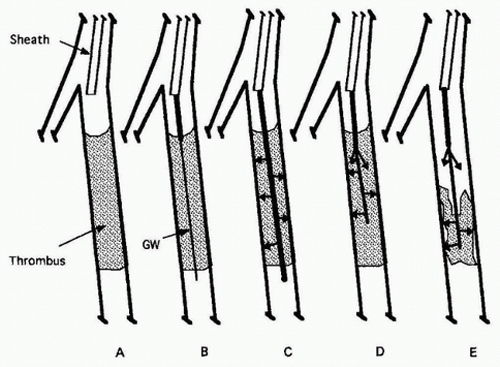Pharmaco mechanical Thrombolysis percutaneous catheter-directed thrombolytic therapy is defined as the process of percutaneous thrombus lysis with the use of special designed interventional equipment and can be achieved currently by simple pharmacological or combined pharmacomechanical thrombolysis.
Pharmacological thrombolysis is herein defined as the process of thrombus dissolution through the selective catheter-directed infusion of thrombolytic agents.
Mechanical thrombolysis (thrombectomy) is herein defined as mechanical disruption of the thrombus.
Pharmacomechanical thrombolysis is herein defined as the mechanical disruption of the thrombus combined with pharmacological thrombolysis.
Stages of IA thrombolysis.
A: An occluded segment of vessel is demonstrated arteriographically.
B: A coaxial catheter is introduced through the IA sheath and advanced into the proximal thrombus, and a guidewire is then advanced to the distal end of the thrombus.
C: A tip-occluded multiside-orifice catheter is advanced into the entire thrombus, which is saturated with a lacing dose of lytic agent deposited by rapid pulse-spray infusion. (Alternatively, an end-hole catheter or a catheter with fewer distal side-holes is advanced distally and then retracted proximally while depositing small doses of the lytic agent at each site.)
D: Continuous infusion is administered with an end-hole catheter with its tip in the proximal thrombus and a smaller side-hole catheter that is advanced much farther into the clot.
(A distal untreated segment of thrombus is shown here, but a side-hole catheter, with its tip occluded, may be advanced so as to bathe the thrombus with the lytic agent throughout its length.)
E: As thrombolysis progresses, both catheters may be advanced, but with this configuration, the inner catheter alone may be advanced into the receding thrombus front. The process continued until the entire thrombus is dissolved and an underlying obstructing lesion is uncovered for treatment by angioplasty or surgery.
Peripheral arterial disease results when the peripheral arteries become too narrow or obstructed and limit the blood flow to the legs.
If left untreated, peripheral arterial disease can cause pain or aching in the legs, difficulty with walking, resting pain in the foot at night in bed, non -healing sores or infections in the toes or feet, and can lead to limb loss in its most severe form.
In addition, it can be associated with other serious arterial conditions leading to heart attacks and stroke.

